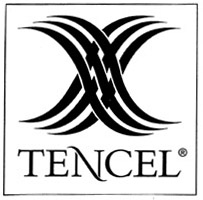
Lyocell, better known by the brand name Tencel®, is a cellulosic fiber. This means that it is regenerated cellulose. Natural cellulose is dissolved from wood pulp and extruded into filaments which are spun into threads and yarns for textile production.
Tencel® is the brand name used for lyocell produced by Lenzig AG, an Austrian company. Lenzig bought American Enka, the company that first produced lyocell, and it is now the only large scale producer.
Lyocell is further classified as a “third generation cellulosic fiber.” In 2015, Lenzig had produced viscose (rayon) for 100 years, Modal for 50 years, and lyocell for 25.
Rayon is the original regenerated cellulose fiber. Modal is a development from rayon. It has a higher wet strength and is machine washable. It is also much softer.
Lyocell has the advantage over rayon and Modal of a more environmentally acceptable manufacturing process. The production first two fibers requires use of bleach, sulfuric acid, and other noxious chemicals to remove lignin and dissolve the cellulose. Lyocell uses an amide acid, an organic solvent, to dissolve the cellulose from wood pulp. From 97% to 99% of the amide acid is recovered and reused. This leaves a much smaller environmental footprint than producing rayon or Modal.
Lyocell (Tencel) is more expensive to produce than rayon. That is why it is usually found in higher priced luxury products, such as the Aireloom Nimbus Pillow. Patagonia, a manufacturer of outdoor clothing, chooses Tencel over rayon (including bamboo rayon) for use in its products primarily because of the environmental impact of manufacturing rayon. Like the other cellulosic fibers, lyocell is biodegradable.
The properties of lyocell do give it some advantages over rayon. Like Modal, it is more washable. It is also stronger, and it is static free. The signature advantage of Tencel is its extra absorbancy. This alone gives lyocell preference over rayon and many other fibers for controlling moisture and temperatures, which accounts for its use in outerwear and activewear. It is also why it appears in a number of mattress covers, for instance some mattress models by Ashley Sleep, Aireloom Bedding, Northwest Bedding, and Simmons Beautyrest.
The newest development for Lyocell (Tencel) is nano-fibrils, extremely small included fibers that increase absorption while making the thread smoother.
Rayon from bamboo is promoted by many as evironmentally friendly because of how bamboo is grown. But that is offset by the process of making rayon from the bamboo. Ed Mass, the President of Yes, It’s Organic, wishes the process for producing Tencel will be applied to bamboo fiber, introducing bamboo lyocell. Would this be called “Bambocel“?
(all accessed on 01/07/2016)
Lenzig AG: http://lenzing.com/
Ohio State University Extension Fact Sheet: http://ohioline.osu.edu/hyg-fact/5000/5572.html
Organic Clothing Blogs: http://organicclothing.blogs.com/my_weblog/2005/11/tencel_sustaina.html
Patagonia: http://www.patagonia.com/us/patagonia.go?assetid=67424
Wikipedia: https://en.wikipedia.org/wiki/Lyocell
Yes It’s Organic: http://www.yesitsorganic.com/rayon-modal-tencel-environmental-friends-or-foes.html#axzz3wbX2WhyO
This entry was posted on Thursday, January 7th, 2016 at 8:30 PM and is filed under beds, fabrics, fibers, mattress covers, wood . You can follow any responses to this entry through the RSS 2.0 feed. You can leave a response, or trackback from your own site.

Get New Post Notification via Email:

7 thoughts on “Lyocell (Tencel)”